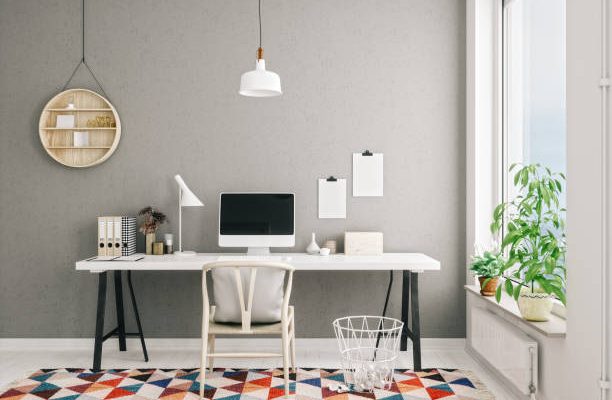Many companies are now exploring the benefits of remote work. It has paved the way for more people to seek jobs that let them perform their duties without leaving the comforts of their home.
Even if it’s just for one day every week, having a dedicated space for work can do wonders for your productivity and work-life balance. This is probably one of the reasons why home offices went from “nice to have” to “must-have” in just a few short years.
Of course, placing a desk and chair in the first vacant space you see isn’t going to cut it, especially if your goal is to be more productive and comfortable while doing your job.
If you’re planning to establish your home office soon, consider seeking help from reliable interior fit-out companies in Dubai.
Of course, you still need to have a bit of knowledge of the task, so it’s best to learn as much as you can about home office design.
To help you out, here are five unspoken design rules you must keep in mind:
1. Prioritize functionality and comfort.
Your workspace at home should let you perform your tasks efficiently and comfortably.
That said, choose an area where you can work without any distractions. This can come in the form of an unused room or a spacious corner away from the living room.
You must also mind the available space for your storage and organizational needs. Depending on your work situation, you may require an area to store books, paperwork, and other supplies to keep them out of sight but not out of reach.
And don’t forget to consider your comfort, especially when buying office furniture.
For example, a desk should be able to accommodate everything you need for your work, not just your computer. There should be an area dedicated to note-taking, reference materials, and a paperwork tray (if needed).
Standard office desks measure 48 inches (120 centimeters) to 60 inches (150 centimeters) wide. Most people prefer wider desks though you may be able to settle with something smaller if you have a smaller laptop.
As for the height, the ideal range is between 28 to 30 inches (70 to 75 centimeters). You can opt for those modern office desks with adjustable heights, but they may not always be the most practical choice for home offices.
Besides a desk, you must also invest in a comfortable, high-quality office chair. Stick to a piece with an adjustable height as much as possible. Even better if you can buy an ergonomic office chair to maintain good posture and ensure comfort.
2. Leave some room for movement.
Interior design experts recommend a 60-by-84-inch workstation to maintain a smooth flow of movement while ensuring the functionality of the workspace. This rule enables you to do your tasks comfortably in your home office.
Besides this expert-approved layout measurement, you can also determine if you have enough space by asking yourself the following questions:
- Will I be able to move to either side of the workstation easily?
- Can I stand up and sit back from my desk without bumping into any furniture?
This may seem obvious, but many people who just recently started working from home don’t get it right the first time.
3. Stay organized.
If you think you can do without physical storage since you only work on a laptop and all your files are online, you’re mistaken.
Many overlook the importance of storage pieces for their home office, but this particular element actually plays a crucial role in productivity.
That said, make sure you have enough filing cabinets, cupboards, or shelving in your home office to keep the clutter at bay. Depending on your workflow, you may need to have a place for:
- the things that just came in;
- those you’re currently working on; and
- the ones you already completed.
Of course, you still need to keep certain files or items within arm’s reach.
If you use other pieces of equipment besides your computer, it would be best to have a storage space specifically made for them. Whether it’s a printer, fax machine, or paper shredder, your equipment must be near you but not displayed in the open for everyone else to see.
The bottom line is that you need to take your time in planning the layout of your office while considering how you can maintain a neat workspace without hampering productivity.
4. Pick the ideal color palette.
Color plays a crucial role not only in interior design but also in productivity. After all, different hues affect a person’s mood and how they feel about any given space.
Many experts believe that certain colors offer psychological benefits to humans, particularly in terms of stress reduction, focus, creativity, and mental stimulation. Ultimately, colors have a way of boosting people’s productivity, inspiring them to do their best possible work.
According to interior design professionals, rich greens, deep yellows, and warm brown tones are ideal for home offices since they alleviate stress while working.
A blend of warm gray and beige makes focusing easier and prevents wandering minds during work hours.
Want something that looks and feels luxurious? Try bringing a dark navy blue element into the mix to create a calming atmosphere.
5. Maximize natural light.
Last but definitely not the least of your considerations is the amount of natural light that can enter your home office.
Good lighting is vital to productivity.
To maximize natural light, put your desk in a window-facing position. Make sure your computer screen won’t be affected by the amount of sunlight streaming into your home office.
If you’re experiencing glare but don’t want to reduce natural light, you can install translucent blinds or sheer curtains.
If there’s not enough natural light, you can enhance the overall brightness of the space by painting the walls a light color and putting up a mirror.
Of course, you may still need to supplement illumination with artificial lighting. When you do, you can choose from one or a combination of the following:
- An overhead light that provides good general lighting.
- Two or more open-top floor lamps placed on the corners of the room.
- A desk light for evenings and shadow-free task lighting.
Work Smoothly at Home
Working from home is the new normal. If you wish to maximize your productivity and the benefits of the remote work setup, design your home office well using the rules listed here. This way, you can make smart decisions when furnishing your home workstation.




















